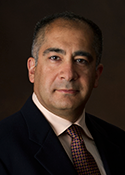 Dr. Sayed Mirbod
Dr. Sayed Mirbod
Recently, a physician friend asked me about the functions of the various dental specialties. In response, I briefly summarized each specialty, attempting to capture the essence of each discipline. When I reached periodontics, I automatically recited what I learned 20 years ago in dental school stating that “the objective of periodontics is to help patients maintain the form, function and esthetics of their teeth for as long as possible.” However, repeating that line made me realize how profoundly things have changed over the last 2 decades. Dentistry has been restructured as an evidence-based discipline and periodontics has been in the forefront of this transformation.
Periodontal medicine, regenerative therapy, periodontal plastic surgery and dental implant surgery are now the main pillars of modern periodontics. In addition, many periodontists are also proficient in the treatment of temporomandibular disorder and occlusal rehabilitation. Evidence-based dentistry has transformed these treatments from a set of recipes for surgical techniques into a science-based approach for the prevention and treatment of disease. Now, it is not a matter of “how” to perform a certain surgical technique but rather a question of “why” and “where” treatment will provide a net benefit to the patient.
Within the context of Canada’s rapidly aging population, the importance of periodontics cannot be overemphasized. As more people reach and surpass age 65, many within this group have become accustomed to a high standard of living and have high expectations for their dental esthetics and function. Yet we must also remember that a large number of seniors also suffer from diabetes, arthritis, cardiovascular disease and a host of other disorders. Periodontal medicine, with its emphasis on reducing chronic inflammatory disease, is particularly suited to address the needs of this population.
Elderly and medically compromised patients can benefit from traditional periodontal procedures aimed at reducing inflammatory disease along with regenerative procedures for avoiding tooth loss. Regenerative and plastic periodontal surgical procedures can prolong the life of an existing dentition and provide for better function and esthetics. If tooth loss becomes unavoidable, dental implants are one option for tooth replacement. However, even with dental implants, it is essential to establish periodontal health in order to ensure success. Accordingly, a comprehensive periodontal examination should be the standard of care in dentistry.
The Canadian Academy of Periodontology (CAP) is a national organization representing most periodontists in Canada. Our members have the knowledge and expertise to provide evaluation and diagnosis of oral disease, to assess risk for future disease progression, and to deliver specialty periodontal nonsurgical and surgical care to patients. Dr. John O’Keefe, CDA director of knowledge networks, has asked CAP to contribute to the JCDA Clinical Q&A website, a content development site where clinical questions are submitted by dentists and answered by expert colleagues. CAP has agreed to provide an evidence-based perspective on all relevant topics in periodontics.
Please visit the CAP website to suggest any special topics that might interest you. Our website also lists contact information for all CAP members. Feel free to use this information to find your local CAP member periodontist as we are only a phone call away and are always are always happy to assist our colleagues.
